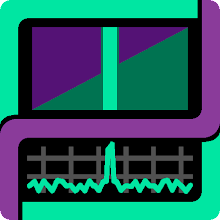http://image.gsfc.nasa.gov/poetry/inspire/advanced.html
A whistler is an atmospheric electrical event that has traveled a very long distance. Usually a whistler is sent out into space and is curved back to earth along magnetic field lines. This long distance allows for a large amount of frequency dispersion which causes a lot of curvature. The original sferics wideband pulse is bent into what looks like an exponential downward sweep.
On the advanced INSPIRE VLF page is a whistler echo train signal file called 6whistechortra.au. It is consists of a primary whistler event and six echoes that are clearly visible in the baudline spectrogram image below:

The NASA INSPIRE page says:
"Echo trains result when the radio wave bounces back and forth between magnetic conjugate points. Each time the signal bounces off the ionosphere, some of the energy leaks down in the lower atmosphere and is heard as a whistler. All of the whistlers in the train are the result of a single lightning stroke. Successive "hops" of the whistler are seen with increasing dispersion time as the distance traveled grows with each bounce."
This increase in dispersion time can be seen in the spectrogram as the whistler echoes becoming increasingly bent. The lower frequencies travel slower than the higher frequencies. What's interesting is how uniform the dispersion is as a function of frequency. Baudline's periodicity measurement bars are a perfect tool for investigating this phenomena. A frequency point on the exponential whistler curve is chosen and then the periodicity bars are stretched and dragged to make the measurement. See the baudline spectrogram image below: (click image for a clearer view of the periodicity bars)

This delta delay varies from 3.1 seconds at about 5300 Hz to 4.5 seconds at 2200 Hz. The periodicity bar measurements line up perfectly at every frequency so these are true echoes and the delta delay is a function of frequency.
The speed of light is about 300,000 km/sec (186,000 miles/second). The shortest whistler echo delay at the highest frequency is 3.1 seconds. So if a constant speed of light whistler velocity is assumed, which it isn't, then the distance traveled equals 930,000 km. The Earth - Moon distance is 384,000 km, so the whistler echo distance traveled is roughly equal to a circular path (diameter * pi) to and from the Moon. This is just speculation and without more detailed information about the whistler echo recording it impossible to say for certain that an Earth - Moon circular path is happening. What is known is that the whistler echoes are traveling a very long distance.
Another interesting observation is by the time of the 4th echo return that the high frequency head of the signal has caught up with the low frequency tail and passed it. The whistler thickness is also increasing with each subsequent echo, so given enough duration, the exponential whistler will dissolve into white noise (equal energy at every frequency) and become spectrally flat.
Fascinating. A lot of physics is going on in this whistler echo train signal.
